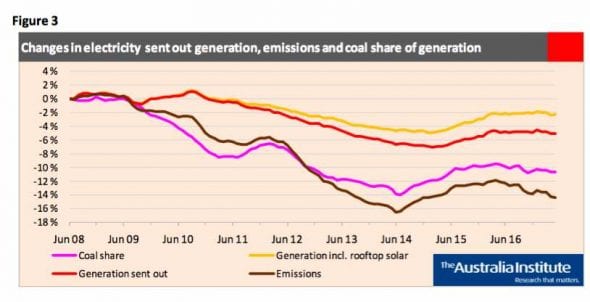A new analysis from The Australia Institute suggests that the renewable energy scenarios put in the Finkel review’s proposed Clean Energy Target will deliver little more, or likely even less, than those proposed by current state-based renewable targets Coalition parties want to kill.
The research by leading energy analyst Dr Hugh Saddler, from the Australia National University, comes in a new quarterly energy report that investigates Australia’s electricity mix and emissions performance.
It shows that Australia is already headed for around 37 per cent large-scale renewable energy penetration in 2030 based on the targets of Victoria (40 per cent by 2025) and Queensland (50 per cent by 2030), which is higher than that envisaged by the Finkel Review with its CET, if you exclude household solar.
“To turn a corner, and show the market the direction we’re heading in, there needs to be a strong ambition accompanying the CET model recommended by Finkel. Otherwise it will be, in effect business-as-usual, by another name,” says Dr Saddler (who RenewEconomy readers will remember from his regulator monthly analyses when at energy consultancy Pitt & Sherry).
The Finkel Review deliberately excluded the impact of the state-based schemes, arguing that neither were actually legislated, and therefore could not be included in its analysis.
Saddler says the really crucial feature of the scheme will be the emissions target it is designed to achieve, a feature almost entirely ignored by both politicians and much political analysis.
This choice of a single, distinctly unambitious emissions reduction target for modelling has been widely and wrongly characterised by many from all sides of the debate as a recommendation of the Review, which it clearly is not,” he says.
“That said, the absence of modelling results for a more ambitious emissions reduction target means that the Report does not provide the range of information needed to conduct an informed debate on target setting.”
Saddler points to another major omission – the increase Australia’s emissions.
“The increase is being driven by gas used to produce Liquefied Natural Gas (LNG) at the three export plants near Gladstone, in Queensland. The LNG-driven increase more than offsets reductions in emissions from electricity generation and petroleum combustion.
“These issues are not addressed in the Finkel Review. Neither are major policies such as the renewable energy targets adopted by the state governments of both Victoria and Queensland, planning for both of which is well advanced.”
Saddler’s analysis also points to how far Australia is off course in its attempts to reach its modest emission reduction targets of 26-28 per cent below 2005 levels by 2030.
This is particularly the case in the electricity sector, where emissions and coal generation has rebounded strongly since the Coalition killed the carbon price in 2014, and sparked a freeze on investment in renewables that has only thawed in the last nine months.
“The urgent need to reduce coal generation, if we are to reduce Australia’s greenhouse gas emissions, is obvious,” Saddler writes.
Saddler’s analysis shows that, in the absence of further policy action, Australia’s total emissions will increase from the 2015 level to between 571 and 616 Mt by 2030, i.e. back to the 2005 level.
“This highlights just how far Australia currently is from being ‘on track’ to achieve its 2030 emissions reduction target,” he says. “In the hype around the Finkel Review, this sobering reality seems to have been forgotten.
“Furthermore, The Audit shows that aside from land clearing and land use changes, energy combustion emissions are also increasing. The data published in The Audit paints a picture of an electricity sector operating without regard for climate policy.”










